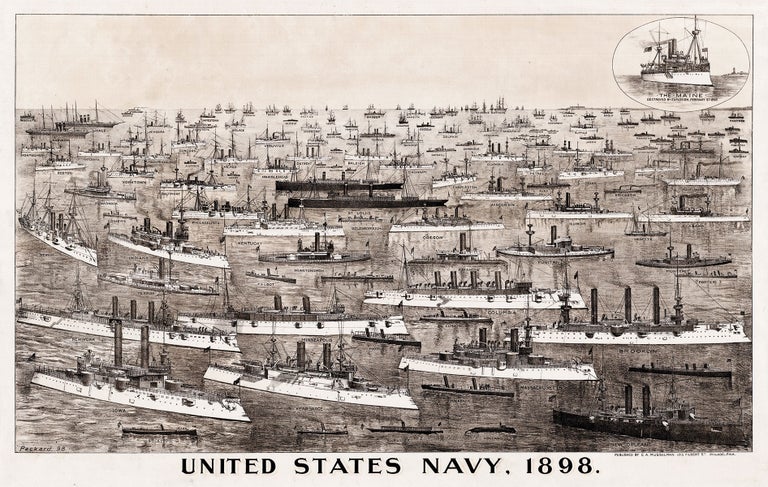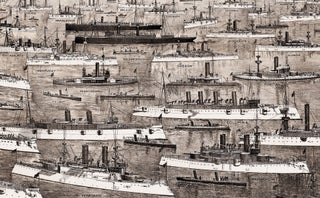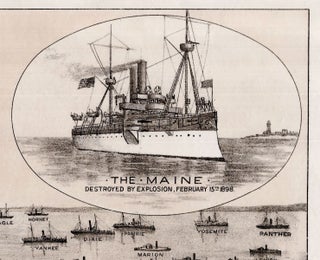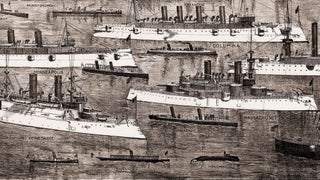United States Navy, 1898.
Philadelphia: C.A. Musselman, 1898. Tinted lithograph, 58 x 97 cm, plus margins. An impressive depiction of the ships of the U.S. Navy at the time of the Spanish-American War, a period when the U.S. emerged as a major naval power. When this print was created the U.S. Navy was transforming itself from a force of ironclads guarding the U.S. coast to a steel-hulled fleet with an increasing international presence. The “Great White Fleet” is featured in the foreground, while a multitude of other ships are represented as well. Several dozen storied ships are depicted and named here—ranging from new steel-hulled battleships such as the USS Iowa (BB-4) and Kearsarge (BB-5) to the submarine USS Holland and smaller ships like the tug USS Sioux. The Civil War-era monitors USS Passiac and Montauk make an appearance as well. A fort is visible on the horizon at the upper right. Also in the upper-right is an inset illustration of the USS Maine , captioned: “Destroyed by explosion, February 15th 1898.” On this date the battleship Maine was sunk in Cuba’s Havana harbor as a result of a mysterious explosion that killed hundreds of its crew members. The U.S. blamed the Spanish who presided over Cuba at the time, and in turn the Spanish-American War broke out in April of 1898. America defeated Spain’s navy and army in a mere three months, and an armistice brought the fighting to an end in August. Spain was forced to cede the Philippines, Guam, and Puerto Rico to America, whereupon President Roosevelt pushed for bolstering the U.S. Navy’s presence in its newly acquired territories and beyond. Following the close of the Spanish-American War, the U.S. Navy would play an increasingly significant role in international affairs. Roosevelt’s new navy was sent around the globe between 1907–1909. Called the Great White Fleet because the ships were painted white rather than the classic gray, the fleet traversed some 43,000 miles and called at 20 ports on 6 continents. Hitherto the world had never seen a naval deployment on such a scale. Generally regarded as one of the U.S. Navy’s greatest peacetime feats, the cruise symbolically established America’s navy as a global power. Prior to the publication of this print, lithographer Herbert S. Packard was a partner in the Philadelphia print and map company Packard & Butler (est. 1879), which primarily produced Christian-themed prints and color advertisements. In 1883, David A. Partridge joined their firm and it was renamed Packard, Butler and Partridge. After the company disbanded in 1893, Packard appears to have operated on his own for a time. He may also have worked for the publisher of this print, C. A. Musselman of Philadelphia, or perhaps created the lithograph independently and sought out Muselman to publish it. A fascinating representation of American naval power on the rise. REFERENCES: Gordon Calhoun, All of the Navy, All in One Place–1898 Print at hamptonroadsnavalmuseum.blogspot.com; McKinley, Mike. Cruise of the Great White Fleet at history.navy.mi; 1898 The Maine Explodes at history.com CONDITION: Very good.
Item #3649
Sold






